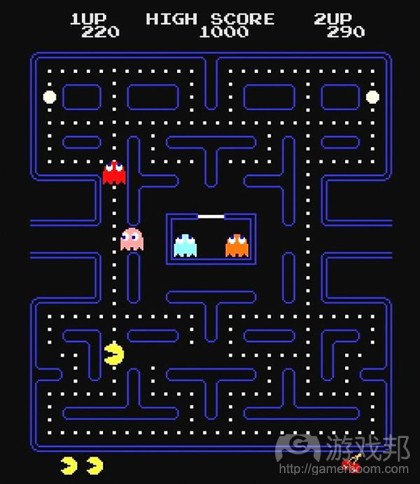游戏设计理论:目标、一致性和控制方式
作者:Mark Wilcox
我喜欢《Atari Graphics and Arcade Game Design》一书中有关游戏设计理论的一篇文章。从考虑玩家及其作为游戏玩家的必须条件方面来看,我觉得文章中所有的内容都很有价值,但其要点在于告诉游戏设计师如何捕捉街机游戏的兴奋点并将其呈现给家用电脑游戏用户。我相信25到30年前流行的街机游戏设计与今日的休闲手机体验设计间存在共通点。
在本文中,我将引用那篇文章的部分内容,并尝试解析其中的含义。
“要让游戏产生挑战性,就应当在游戏中设置结果不确定的目标。如果在游戏中,玩家肯定能够实现目标或肯定无法实现目标,那么这样的游戏不可能具有挑战性,玩家也会失去兴趣。将随机性引入游戏是件很简单的事情,可以隐藏起重要信息,或者引进导致玩家面临灾难的随机变量。注意不要过度,因为完全依赖随机性的游戏缺乏足够的技能因素。玩家很快就会发现,他们根本无法控制游戏的结果。”
玩某款游戏后因为未感受到挑战而迅速失去兴趣,你曾经多少次碰到这种情况呢?这种事情我经历过许多次,我的游戏《Dragons》的挑战性也有待改进,这是我接下来要着手处理的问题。
作为设计师,我们有时可能会过度使用事件的随机性。
对于任何游戏设计来说,清晰的结构配上清晰呈现但遥不可及的目标,这是个良好的设计起点。以《吃豆人》为例,布满整个迷宫的豆子和嘴巴让玩家清晰地意识到自己需要完成的是个庞大且复杂的任务。
“规则的逻辑架构是任何游戏中更为重要的设计元素。规则可能极为简单,也可能相当复杂,但是它们必须是有意义的。因为游戏必须遵从其主题,所以任何规则及其变体都应当直接由主题延伸出来。添加与游戏主题不相符的元素是毫无意义的做法,因为这些内容会让玩家感到困惑,使游戏变得更为困难。比如,《大金刚》这款堪称史上最佳跳跃和攀爬街机游戏,它完全不要求玩家做出射击动作,只需要避开障碍物到达目标即可。同样,《小蜜蜂》之类的射击游戏也不会通过其他游戏元素来影响敌人的流畅攻击。”
无论你将什么内容定义为玩家需要克服的挑战,这些内容都应当具有逻辑意义。比如,你不能随意改变游戏的控制方式,这只会增加游戏的复杂性,从而困扰和激怒玩家。我自己就犯过这种错误。
《精灵战争》的游戏设计总是能够令我感到骄傲。游戏执行上具有一致性,而且上手也相当容易。玩家只需要点击屏幕来移动精灵,收集闪光的东西同时避开障碍即可。
“理想的街机游戏应当在游戏所有关卡中培养胜利感。清晰和简单的游戏设计是个重要因素。过多的细节或规则可能会让玩家感到害怕。如果玩家认为他的失败缘由是过于复杂游戏中的瑕疵或控制方式,那么他会认为游戏是不公平的,就此离开游戏。反之,如果玩家觉得失败源于自己不断犯下的错误,那么他就会相信游戏是可以战胜的,就会重复玩游戏来改善自己的技能。玩家会说服自己一次次地玩游戏。”
在现代游戏中,《愤怒的小鸟》做到了这点,它是一款具有良好易用性的游戏,我们都觉得再试一次或许就可以打通关卡。我们只需要再次拉动弹弓上的弹绳,将小鸟瞄准那些脆弱的建筑即可。
我想说的是,游戏的控制方式如此简单,使玩家不会将自己的失败归咎于复杂控制方式造成的问题,他会认为是自己的瞄准或力量出现偏差。游戏的入手相当简单,但是要做到精通却非常困难。
文章中有许多有价值的东西,我认为所有对街机游戏设计有兴趣的人都可以去阅读和研究。
那么,我从这篇文章中学到了什么呢?做个简单的总结。
1、确定游戏目标,确保将其清晰地呈现给玩家。看看《吃豆人》,游戏的挑战和目标显而易见。
2、保持一致性和逻辑性。仍以《吃豆人》为例,游戏有着非常显眼的规则和限制条件,不会让玩家感到困惑。你的角色是张大嘴,需要走遍迷宫吃豆子,鬼魂会捕捉你。如果你觉得这显得不公平,那些大豆子的存在就是为了满足你反制鬼魂的需求。
3、尽量保持游戏控制方式简单易懂,这样玩家才不会认为他们无法战胜挑战。以《愤怒的小鸟》为例,简单是游戏的关键,呈现出能够控制玩家行为的游戏体验。
最为设计师,我认为街机游戏设计的精妙之处值得学习。尽管与现代游戏相比,这些游戏稍显落后,但有时却能够激发创新意识。
游戏邦注:本文发稿于2012年2月1日,所涉时间、事件和数据均以此为准。(本文为游戏邦/gamerboom.com编译,拒绝任何不保留版权的转载,如需转载请联系:游戏邦)
Game Design Theory – Goals, Consistency and Controls
Mark Wilcox
I love this article on Game Design Theory written several years ago for the book Atari Graphics and Arcade Game Design. Everything about it I find compelling and valuable in terms of considering the player and his requirements as a gamer. It goes in to detail about the benefits of well defined and above all fun challenges. It even touches on the player’s ego and its relevance to the broader game experience.
Naturally it was written at a time when arcades were king and home computing was still very much on the back foot. In fact the whole point of the article is how we as designers can capture the thrills of the arcade for the home gaming audience. It really is a perfect chapter for someone like me with a retro fascination in arcade gaming and a future that is very much about designing arcade thrills for mobile phones.
I’ve written about this several times before but I do believe there is a link between designing for the arcades of 25 – 30 years ago and designing for today’s casual mobile experience.
So let me pull just a couple of sections out of the article and try to make sense of them.
For a game to be considered challenging, it should have a goal where the outcome is uncertain. If the player is certain to reach the goal or certain not to reach it, the game is unlikely to present a challenge, and the player will lose interest. It is very easy to introduce randomness into the game either by hiding important information or by introducing random variables that draw the player toward disaster. Be careful not to overdo this, since a totally random game lacks a skill factor. Players quickly discover that they have no control over the outcome.
How many times have you played a game and quickly lost interest because you are just not challenged? I see evidence of this quite a lot and have myself fallen foul of it. (My Dragons game needs a better challenge, for example. It’s something that I aim to address at some point.)
The point about randomness is of course totally valid. As designers we probably rely on the randomisation of events a little too much.
A clear structure to your game with a well defined but out of reach goal is a great starting point for any design. Look at PacMan as an example. A maze full of dots and an animated mouth is a very clear instruction to the player of what she should achieve but is still quite clearly a) a big task and b) tricky.
One of the more important design elements in any game is a logical set of rules. The rules can be extremely simple or utterly complex, but they must make sense. Since the game must follow its theme, any rules or variations should stem directly from that theme. It is pointless to throw in game elements that simply don’t belong just because you think that confusing the player would make the game more difficult. For instance, Donkey Kong, one of the best jumping, climbing arcade games, doesn’t require the player to shoot everything in sight, just avoid obstacles to reach the goal. Similarly, a tough, shoot-’em-up game like Galaxian keeps its fluid alien attack uncluttered by distracting game elements.
I suppose this is straight forward.
Whatever you define as your challenge for the player to overcome it should make logical sense. You really cannot afford to switch the rules of controlling the game, for example, just to add complexity. It doesn’t do that at all it just confuses and irritates the player. I have myself learned this lesson the hard way.
That said a game’s design that I was always proud of was Wizard Wars. It was consistent in its execution and extremely simple to pick up. Just tap the screen to move the Wizard and collect the shiny things whilst avoiding the nasty things.
The ideal arcade game should foster the illusion of winnability at all levels of play. One important factor is a clean and simple game design. Too much detail or too many rules may intimidate the player. If a player believes that his failure was caused by a flaw in an overly complex game or by the controls, he will consider the game unfair and quit. On the other hand, if a player perceives failure to be attributed to correctable errors on his part, then he believes the game to be winnable and will play repeatedly to master the game. It’s as if the player teases himself to play one more time.
In modern gaming this is epitomised by the game Angry Birds. Love it or hate it, it is an immediately accessible game and one that we all feel that we can conquer with just one more “go”. I mean what could be more simple than pulling the elastic on a catapult and aiming your bird to arc its way in to a fragile structure.
I guess the point I’m trying to make is that the controls are so simple that the player won’t ever attribute his failure to a problem with complex controls he will always assume that his aim or power was incorrect. Ludicrously simple to learn and yet extremely difficult to master. At least in one sitting.
These are just three of the numerous things that jumped out at me from the chapter.
There is a lot to take in within the chapter and I implore anyone with an interest in arcade game design to study it.
So what have I learned? Here is just a short summary.
Define your goals well and make sure they are clearly visible to the player. Consider Pac-Man and how visible and obvious its challenges and goals are.
Be consistent. Be logical. Again consider Pac-Man and its very obvious and visible rules and restrictions. There can be no confusion. Your avatar is a chomping mouth. The maze is littered with dots to eat. The ghosts are coming for you. Surely that’s not fair? What do the flashing dots do …?
Make your controls simple and fool proof such that the player won’t ever confuse them with his inability to conquer the challenge. Consider Angry Birds. Simplicity is key. I’m sure there is further scope for analysing the balance between minimal input from the player in return for maximum chaos on the screen. A truly masterful game experience.
I really don’t wish to sound like someone who is obsessed with a formulaic approach to something that should be really quite natural. But I do believe that as designers we do well to learn from the experiences of the masters of arcade game design. These guys had nothing compared to modern gaming environments. Sometimes having very little forces some great innovation. (Source: HTML5 Game Design and Development)
下一篇:简述创建游戏设计文件的四大步骤










































 闽公网安备35020302001549号
闽公网安备35020302001549号